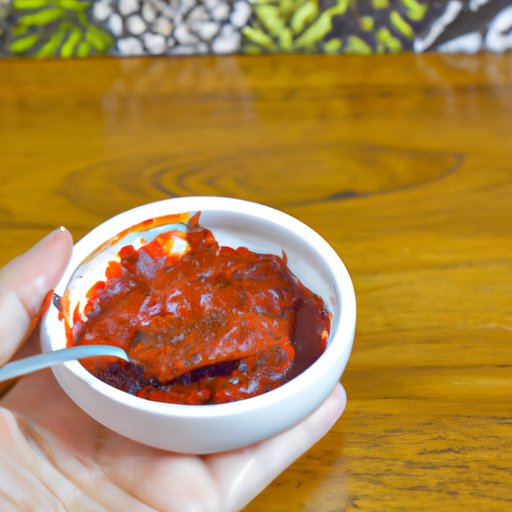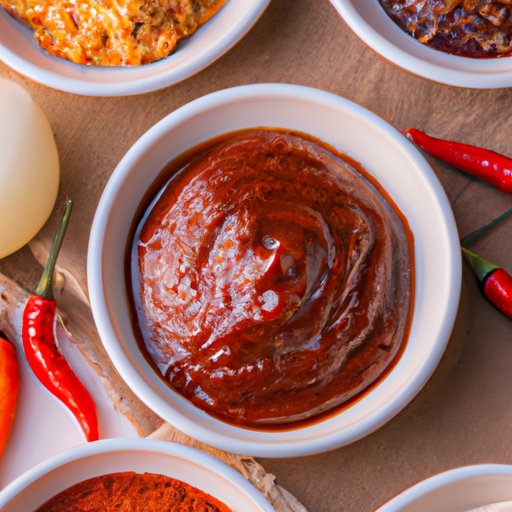Introduction
Gochujang is a staple condiment in Korean cuisine, often used as an ingredient in dishes such as bibimbap, tteokbokki, and jeon. But what does the science tell us about its healthfulness? In this article, we’ll explore the nutrition profile of gochujang, its potential health benefits, and its potential risks to help you make an informed decision about whether it’s suitable for your diet.
Analyzing the Nutritional Content of Gochujang
Gochujang is a fermented condiment made from red chili peppers, glutinous rice, fermented soybeans, and salt. It has a deep, spicy flavor that adds a unique dimension to many traditional Korean dishes. Let’s take a look at the macronutrient profile of gochujang.
Macronutrient Profile
A single serving (1 tablespoon) of gochujang contains:
- Calories: 25
- Total fat: 0 grams
- Saturated fat: 0 grams
- Carbohydrates: 6 grams
- Fiber: 0 grams
- Protein: 0 grams
Vitamin and Mineral Content
Gochujang is not a significant source of any vitamins or minerals. However, it does contain small amounts of several vitamins and minerals, including calcium, iron, potassium, and vitamin A.
Calories Per Serving
One tablespoon of gochujang contains 25 calories, so it can be a good choice for those trying to watch their calorie intake. For example, if you were to replace two tablespoons of mayonnaise with one tablespoon of gochujang, you would save around 100 calories.

Exploring the Health Benefits of Gochujang
Despite its relatively low calorie count, gochujang does offer some health benefits. Let’s take a look at some of them.
Antioxidants
Gochujang contains high levels of antioxidants, which can help protect your body from damage caused by free radicals. These antioxidants also have anti-aging properties, which can help keep your skin looking youthful and healthy.
Anti-Inflammatory Properties
Gochujang also has anti-inflammatory properties, which can help reduce inflammation in the body and reduce the risk of certain chronic diseases. Studies have shown that regular consumption of gochujang can reduce markers of inflammation in the body.
Heart Health Benefits
Gochujang is low in saturated fat and cholesterol, making it a heart-healthy choice. Additionally, studies have shown that regular consumption of gochujang can reduce levels of “bad” LDL cholesterol in the blood, which can lower the risk of heart disease.
Examining the Potential Risks of Eating Gochujang
Although gochujang offers some health benefits, there are also some potential risks associated with eating it. Let’s take a look at two of the most common concerns.
High Sodium Content
Gochujang is high in sodium, with one tablespoon containing around 400 milligrams. This is almost 20% of the recommended daily limit for adults. Eating too much sodium can raise blood pressure, which increases the risk of heart attack and stroke.
High Sugar Content
Gochujang also contains high levels of sugar, with one tablespoon containing around 4 grams. Eating too much sugar can lead to weight gain, increased risk of diabetes, and dental cavities.

Investigating the Role of Gochujang in Traditional Korean Cuisine
Gochujang has been a part of Korean cuisine for centuries. Let’s take a look at its history and some of the most popular dishes that use it.
History of Gochujang
Gochujang has been a part of Korean cuisine since the 17th century. It was originally made from fermented soybean paste, chili peppers, and glutinous rice, and was used as a condiment to add flavor to dishes. Over time, the recipe for gochujang evolved, and today it is made with a variety of ingredients, including red chili peppers, glutinous rice, fermented soybeans, and salt.
Popular Dishes With Gochujang
Gochujang is used in a variety of traditional Korean dishes, including bibimbap, tteokbokki, and jeon. It is also commonly used as a marinade for meats, such as bulgogi and galbi, and as a dipping sauce for dumplings and other fried foods.

Comparing Gochujang to Other Popular Condiments
Gochujang isn’t the only condiment on the market. Let’s compare it to three of the most popular condiments.
Sriracha
Sriracha is a popular Asian-style hot sauce made from red chili peppers, garlic, vinegar, and sugar. It has a similar flavor to gochujang, but it is spicier and sweeter. It also contains fewer calories per serving than gochujang.
Soy Sauce
Soy sauce is a dark, salty condiment made from fermented soybeans. It has a distinct umami flavor, and it is often used as a dipping sauce or as an ingredient in marinades and sauces. Soy sauce has a higher sodium content than gochujang, so it should be consumed in moderation.
Hot Sauce
Hot sauce is a spicy condiment made from chili peppers and vinegar. It has a similar flavor profile to gochujang, but it is much spicier. Hot sauce also has a significantly higher sodium content than gochujang.
Debunking Common Myths About the Healthfulness of Gochujang
There are a few misconceptions surrounding the healthfulness of gochujang. Let’s debunk two of the most common myths.
Misconceptions Regarding Its Spiciness
Some people believe that gochujang is too spicy to be healthy, but this is not true. Gochujang has a deep, savory flavor, but it is not overly spicy. The heat level can vary depending on the brand, but it is generally milder than hot sauce.
Misconceptions Regarding Its Sodium Content
Another common misconception is that gochujang is too high in sodium to be healthy. While it is true that gochujang is high in sodium, it can still be enjoyed in moderation. Try pairing it with other low-sodium foods, such as fresh vegetables, to balance out the overall sodium content of your meal.
Conclusion
Gochujang is a popular condiment in Korean cuisine, and it can be a healthy addition to your diet. It has a number of potential health benefits, including antioxidants, anti-inflammatory properties, and heart health benefits. However, it is also high in sodium and sugar, so it should be consumed in moderation. When compared to other popular condiments, gochujang can be a healthier option, provided that you watch your portion sizes.
Summary of Findings
Gochujang is a fermented condiment used in traditional Korean cuisine. It is low in calories and contains some vitamins and minerals, as well as antioxidants and anti-inflammatory properties. However, it is also high in sodium and sugar, so it should be consumed in moderation. When compared to other popular condiments, gochujang can be a healthier option, provided that you watch your portion sizes.
Final Thoughts
Overall, gochujang is a flavorful and nutritious condiment that can be enjoyed as part of a balanced diet. It can be used to add flavor to a variety of dishes, and it has a number of potential health benefits. Just remember to watch your portion sizes and be mindful of the sodium and sugar content.
(Note: Is this article not meeting your expectations? Do you have knowledge or insights to share? Unlock new opportunities and expand your reach by joining our authors team. Click Registration to join us and share your expertise with our readers.)
